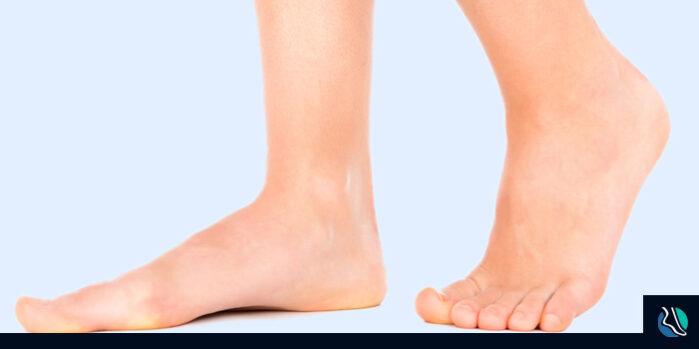By Dr. David M. Pizzano | If you’re as old as I am, you may have been subjected to, or know people who were subjected to archaic foot aligning devices, that were attached to shoes and usually worn at night. On a lesser scale perhaps your mom and dad brought you to a children’s shoe store only to buy you profoundly ugly and self-esteem destroying shoes. I can happily report that very few of us Podiatrists or other foot professionals find the need to recommend these kinds of devices/shoes with the exception of true foot and/or ankle deformity.
The general public perceives the flat foot in so many different ways that I feel obligated to clarify what it really means to have a flat foot. I can’t even count how many patients come to my office stating that had been told their entire life that they are “flat footed”. Yet I look at their feet and see a perfectly formed arch. When a person stands, their arch will naturally get closer to the ground, regardless of foot type. This is simply the effect of gravity. However, if you stand up and your arch completely hits the ground with no daylight underneath, then you are the proud owner of a flat foot.
Most children, with the exception of children born with clubfoot or other neuromuscular disorders, are born with flat feet. The bones of the foot don’t develop fully until later in life. Until those bones have at least partially formed, the arch will not become apparent. This usually happens around the age of 4 or 5. Even when a flat foot is identified at this stage, we as Podiatrists generally do not treat the flat foot unless there is pain or difficulty in walking or running. A parent should avoid classifying all foot, ankle and leg pain as “growing pains”. Normal growth should not be painful.
Those adults with flat feet can probably recall their youth, trying to keep up during running sports or complaining of foot, ankle and knee pain. The truth is that until the child reaches a weight that exerts enough force on the foot, the flat foot will remain asymptomatic. I don’t think I need to explain how excessive weight would play a role here.
 When symptoms do appear this is when a Podiatrist will jump to action. An evaluation usually involves examining the foot sitting, standing and walking. X-rays may also be taken to assess bone structure. We will assess how much or little the foot is “pronated”. Pronation is the process by which the heel moves to the outside of the leg and the ankle sags to the inside of the leg (see diagram). Over pronation is usually the culprit for most foot, ankle and knee pain that accompanies the flat foot.
When symptoms do appear this is when a Podiatrist will jump to action. An evaluation usually involves examining the foot sitting, standing and walking. X-rays may also be taken to assess bone structure. We will assess how much or little the foot is “pronated”. Pronation is the process by which the heel moves to the outside of the leg and the ankle sags to the inside of the leg (see diagram). Over pronation is usually the culprit for most foot, ankle and knee pain that accompanies the flat foot.
The most common first course for most people is the over-the-counter arch support that can be purchased at any pharmacy or department store. It should be noted here that over-the-counter arch supports (Dr. Scholls and the like) are minimally corrective and mostly serve to simply cushion the foot against ground forces.
Your Podiatrist will most likely start with some kind of prefabricated device to help reduce pronation to begin the pediatric flat foot treatment. These devices are supplied by the physician, approximate the shape of the arch, and are heat molded in the office to fit the patient’s foot.
In more severe cases or where those prefabricated devices have failed, a custom molded foot orthotic will be recommended. Custom molded foot orthotics are made from a mold (plaster, foam or digital) of the foot. We at Roxbury Foot and Ankle Center of NJ actually now specialize in 3D printed orthotics. Anyway, what makes these better than prefabricated devices is that they more accurately correct biomechanical imbalances. This incidentally, is my only choice for the athlete at any age. It’s the most effective method to treat and prevent foot, ankle and knee injuries.
In closing, I don’t want to minimize the significance of the flat foot. Treating a symptomatic flat foot can prevent many future problems including foot, ankle and knee arthritis, hip, and back pain. If you or your child has flat feet and complains of foot, ankle or knee pain, it would be in your best interest to visit your local Podiatrist.
How Useful Was The Information On This Page
[rating_form id=”1″]







